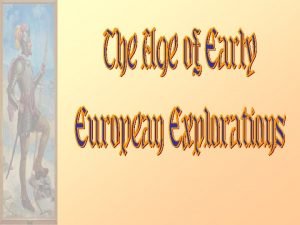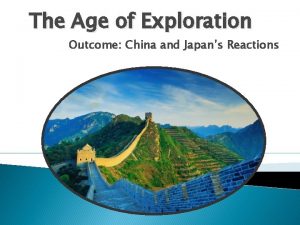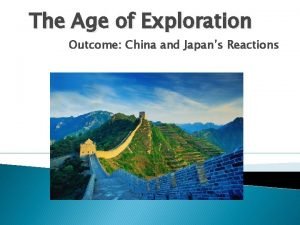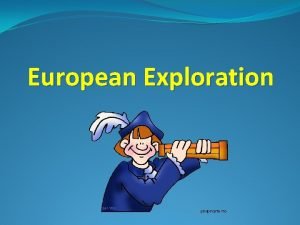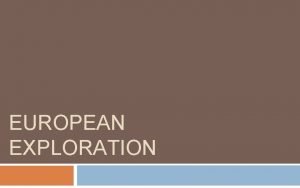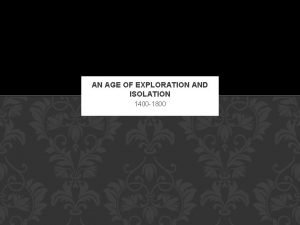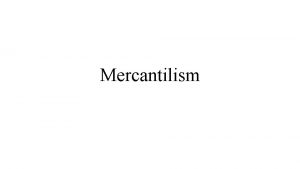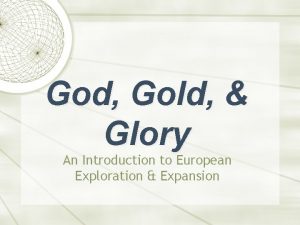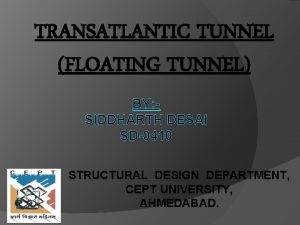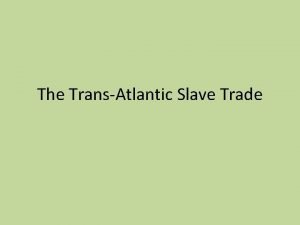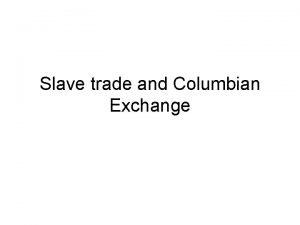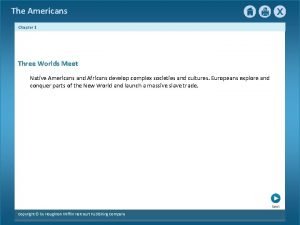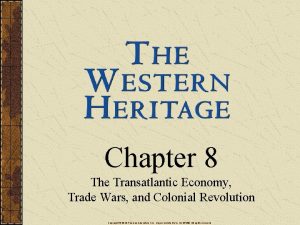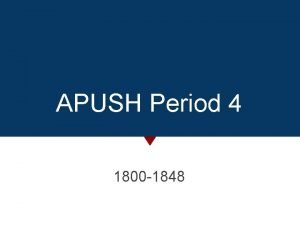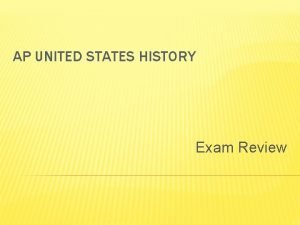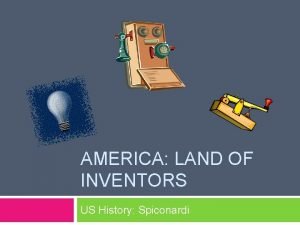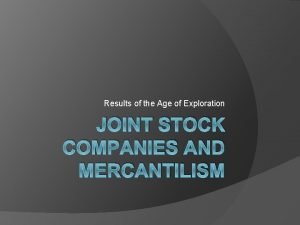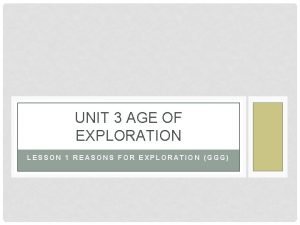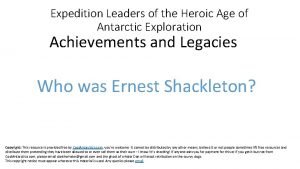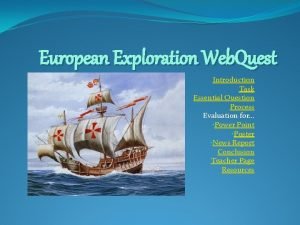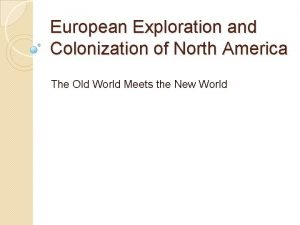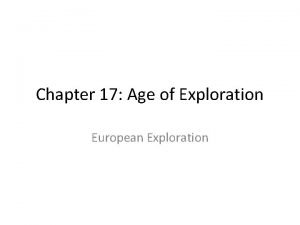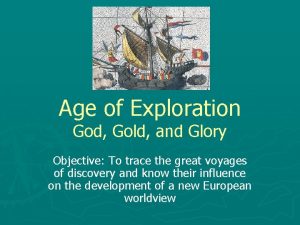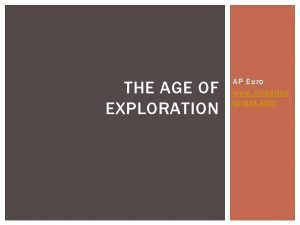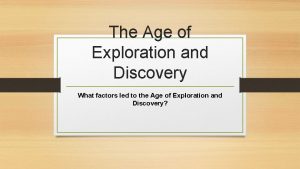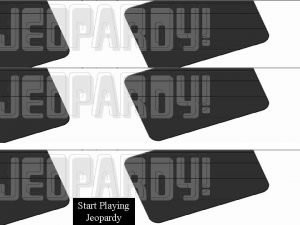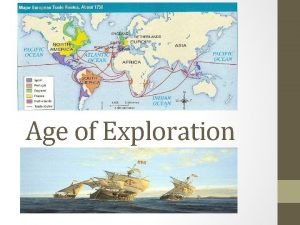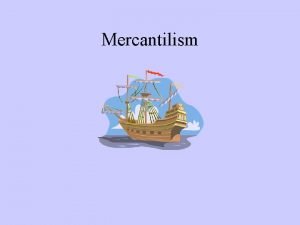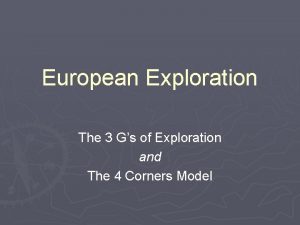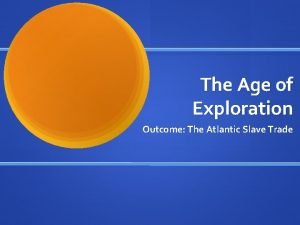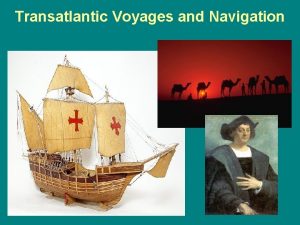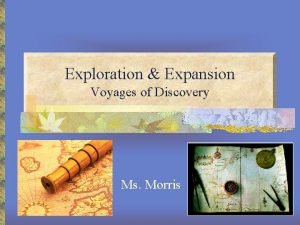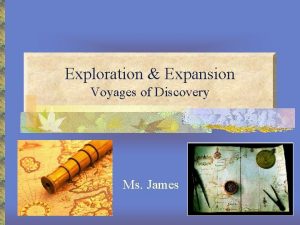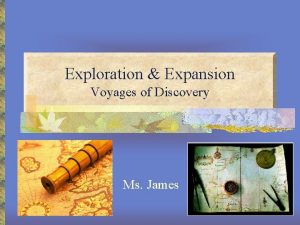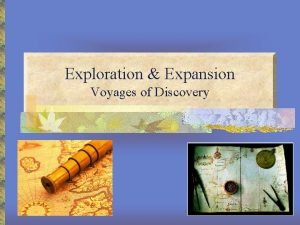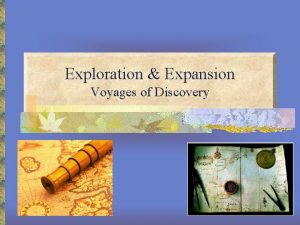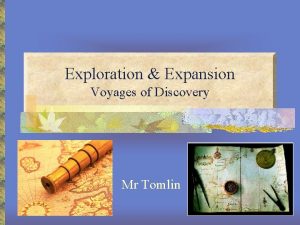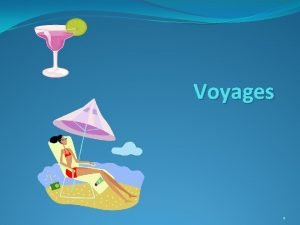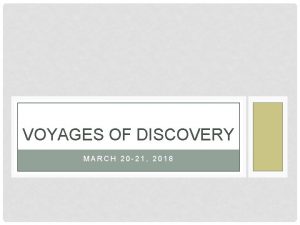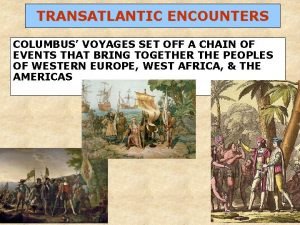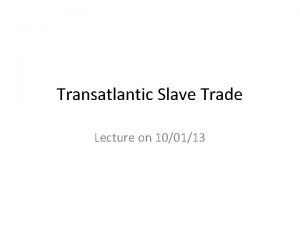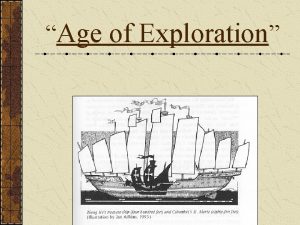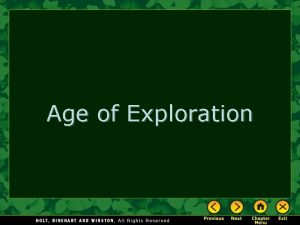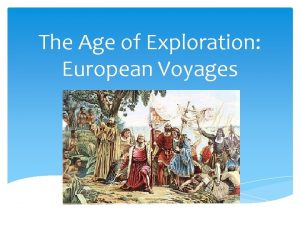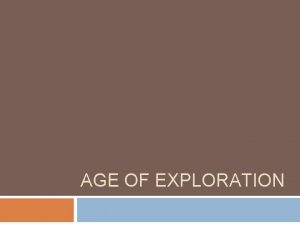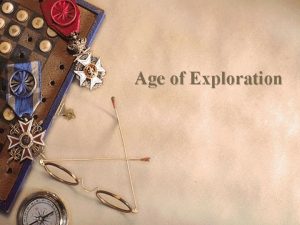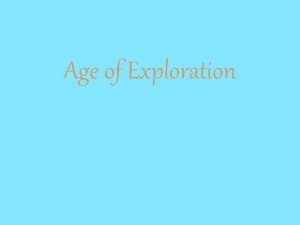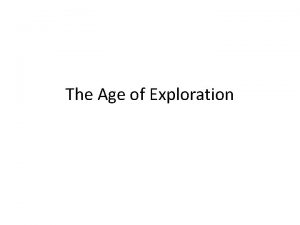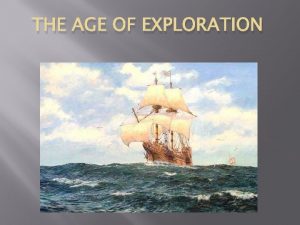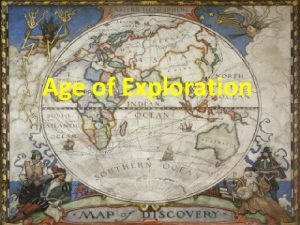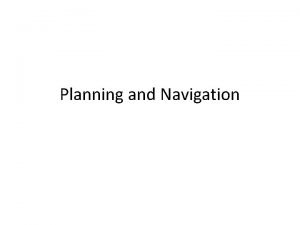Transatlantic Voyages and Navigation The Age of Exploration
































![Voyage around the World (1519 -1522) • Fernao Magalhaes [Magaljenš] • set out with Voyage around the World (1519 -1522) • Fernao Magalhaes [Magaljenš] • set out with](https://slidetodoc.com/presentation_image_h2/b3f40e4dc611cdca19e9678630132fd2/image-33.jpg)






- Slides: 39

Transatlantic Voyages and Navigation

The Age of Exploration European sailors and ships -> left the Old World (Portuguese, Spanish, British, French, Dutch) -> set out to discover – the Other World -> later called “Mundus Novus” or New World -> exploration turned into exploitation (befriend, exploit, kill) e. g. 1495 – armed conflict in Hispaniola Out of 250. 000 in 1492, 500 remained in 1538!!!

The Waldseeműller Map of 1507 A German cartographer credited for the first use of the word America on the 1507 map Universalis Cosmographia in honor of the Florentine explorer Amerigo Vespucci explored parts of South America.

Fabled land in the East • Europeans didn’t know the faraway lands in the East • their conception of these lands were inaccurate • new information – Marco Polo (system of roads, jade, paper money usage, etc. ) • Arabian merchants – brought new products (satin, artichoke, aubergine, musical instruments, carpets, etc. )

What made the civilization of the Renaissance turn to discovery? 1. Willingness to learn and understand other cultures (curiosity – to know AMAP) 2. Religious desire to save souls (and the myth of Prester John), Portuguese looked for Christians in Africa, however, found none 3. Economic reasons – attacked by the infidels – Muslims, needed new resources of precious metals (gold and silver) 4. Imperialism – colonization of foreign lands

Marco Polo and his travels • Marco Polo was born in 1254 in Venice, Italy. In 1271 he accompanied his father and uncle on their way to the East. Three years later they got to Beijing and stayed there for 17 years. • Marco was soon working for the Emperor. Upon his return to Italy Marco was put in prison where he dictated his memoirs to his friend Rusticelli. • This work became known as „Il Million“

Marco Polo’s Travels

Marco Polo at Khubilai Khan

trade – caravans – Silk route • mainly luxurious items – chinaware, silk, gold, pearls, precious stones, jewels, rare spices (pepper, cinnamon, nutmeg, ginger, clove, etc. ) • Silk route – across Asia to the Black and Meditteranean seas


silk route

1453 – Fall of Constantinople • they took control over the sea and land routes • They collected high fees for using the Bosporus strait • Europeans began their search for new routes to India and China

Navigation around Africa • Portuguese – at first they sailed to North Africa – imported ivory, gold and black slaves • Prince Henry, called the Navigator (started to subsidize sailors, mapmakers, astronomers, shipbuilders and instrumentmakers) • Bartholomew Diaz – endeavoured to sail around Africa, but his sailors were worried and forced him to return • Cape of Storms – (later) Cape of Good Hope

Many obstacles to success • Geographical knowledge of the world was not what it is today – e. g. It was believed that Malaysia and Africa were connected, no maps • Danger of ocean travel itself – e. g. Oceans were inhabited by dragons and sea monsters and there were great holes in which the ships would simply disappear • The explorers did not know exactly where they were going. (e. g. Columbus believed that Japan (Cipango) was just some 3, 700 km away from Iberian Peninsula)

Technological necessities 1) 2) 3) chronometer astrolabe magnetic needle or compass a) b) c) measures latitude showed north measured longitude I. II. Not available until the 18 th century Known to the ancient Greeks, improved in 15 th century Came to Europe from the Arab world in 12 th century III.

Answers 1) chronometer c) longitude (E-W) I) not until 18 th c. 2) astrolabe a) latitude (N-S) II) known to Greeks 3) compass b) showed north III) from the Arabs


Vasco da Gama • 1498 – he arrived in India after having sailed around the south tip of Africa and thus started the era of vivid trade with spices in the first place, but also other goods (1488 – B. Diáz – Cape of Good Hope) • 1500 – the Portuguese reached Brazil (Pedro Alvárez Cabral) and it has made it the only country in South America where not Spanish, but Portuguese is spoken

Portugal overseas empire - over the next 25 yrs, Portugal built and empire that remained entirely dependent on sea power - rather than colonize its new territories, Portugal set up a number of trading depots from West Africa to China - little attempt, if any, to conquer these lands by force - military outposts with the sole task of protecting their investments - voyages financed by Flemish, German and Italian bankers (Antwerp soon replaced Lisbon as center of spice trade) - between 1501 -1505 (7000 sailors total)

Division of the non-Christian world between Portugal and Spain

Portuguese Empire

second wave of expansion and exploration - the Spanish - unlike Portugal, Spain founded its empire on conquest and colonization, not trade - most important endeavors were the ones of - Christopher Columbus (En) Cristoforo Colombo (It. ) or Cristóbal Colón (Sp. ) - Vasco Nunez de Balboa - Fernao Magalhaes (a Portuguese in Spanish services)

Christopher Columbus and the New World • He was born in ____, v Itálii • He believed that the Earth is ____kulatá • He tried to persuade the king of Portugal to organize a voyage across the Atlantic – but didn’t succeed (also applied to king Henry VIII) • In the end he left for Spain and entered the services at the royal court • queen Isabela and king Ferdinand • He set sail on August 3, 1492 with three ships:

Santa Maria – small carrack

What is a carrack? • A carrack is a 30 -40 metres long and approximately 10 metres wide ship. It was a large and heavy vessel with high sides and great loading capacity, which was 100+ tons. It had four decks. The prow and stern pass into a high and square extension. • A carrack was a three-mast vessel with a stern rudder

Pinta – a Spanish caravel

Nina – a Spanish caravel

Where did Columbus get to? • The island of San Salvador in the Carribean • today’s group of islands of the Bahamas • later founded the first permanent European colony in the New World on the island of Hispaniola (today’s Haiti and Dominican Republic] • He named its inhabitants Indians (India) • Until his death he believed he had reached India • He undertook a total of 4 voyages

Hispaniola

San Salvador

Columbus's 4 voyages 1 the Bahamas/Haiti and Dominican Republic/Cuba 2 Dominica/Virgin Islands/Puerto Rico/Jamaica 3 Trinidad and Margarita 4 explored the coast of Nicaragua, Panama and Costa Rica

„Pacific Ocean“ and going south - 1513 (6 years before the conquest of Mexico - the Aztec Empire) - Vasco Núňez de Balboa - made further explorations south possible, crossed the isthmus of Panama and saw the „South Sea“ - Pacific Ocean
![Voyage around the World 1519 1522 Fernao Magalhaes Magaljenš set out with Voyage around the World (1519 -1522) • Fernao Magalhaes [Magaljenš] • set out with](https://slidetodoc.com/presentation_image_h2/b3f40e4dc611cdca19e9678630132fd2/image-33.jpg)
Voyage around the World (1519 -1522) • Fernao Magalhaes [Magaljenš] • set out with 5 vessels • they sailed around South America and then through a strait into an ocean which they named Pacific (quiet, peaceful) • In the Philippines they met the natives and a great majority of them perished • Only one ship returned, without Magalhaes

1519 - 1521

Other „explorers“ - conquistador • • Hernán Cortés– Aztec civilization, Mexico army of 550 troops, 250 Indians depended on the help of Aztec enemies brought Central and parts of South America under Spanish control – territory larger than Spain itself • victory due to advanced technology • especially artillery • Aztec population was reduced from 25 to 2 million !!! Especially due to communicable diseases such as smallpox!!!

Hernán Cortés

Francisco Pizarro • he conquerred the Incan Empire of Peru after having imprisoned the last Incan Emperor Atahualpa • gold and silver flooded to Europe, especially after the huge silver deposit was found at Potosi • aim of the Spanish – convert the natives to Christianity, extend Spain's power over its lands and gain some profit • encomienda – large manors w/ „slave labour“ the results of encomienda was the taxation and forced labour of the local populations in exchange for protection and salvation of souls

Pizarro seizing the last Incan Emperor of Peru

The results of overseas explorations • • gold and silver flooded to Europe improving economy population growth awareness of new parts of the globe restoration of European self-confidence Europe rediscovered itself the rise of colonial empires transfer of slaves, animals, plants and diseases • explotation of native civilizations etc.
 What is the cycle of conquest
What is the cycle of conquest Stone age, bronze age iron age timeline
Stone age, bronze age iron age timeline Iron age bronze age stone age timeline
Iron age bronze age stone age timeline The age of exploration outcome china and japan's reactions
The age of exploration outcome china and japan's reactions Japan during the age of exploration
Japan during the age of exploration God gold glory drawing
God gold glory drawing God gold and glory motivations for the age of exploration
God gold and glory motivations for the age of exploration Dutch exploration routes
Dutch exploration routes Chapter 19 an age of exploration and isolation
Chapter 19 an age of exploration and isolation God gold and glory age of exploration
God gold and glory age of exploration The transatlantic question
The transatlantic question Transatlantic tunnel project
Transatlantic tunnel project Transatlantic slave trade pictures
Transatlantic slave trade pictures Gustavus swift inventions
Gustavus swift inventions Transatlantic slave trade apush
Transatlantic slave trade apush The transatlantic slave trade
The transatlantic slave trade Chapter 1 three worlds meet
Chapter 1 three worlds meet Transatlantic slaves
Transatlantic slaves 1800 apush significance
1800 apush significance Triangular slave trade
Triangular slave trade Transatlantic encounters in history of education download
Transatlantic encounters in history of education download Transatlantic telegraph cable apush
Transatlantic telegraph cable apush Joint stock company age of exploration
Joint stock company age of exploration Ggg
Ggg Age of exploration chart
Age of exploration chart Age of exploration videos
Age of exploration videos Cool antarctica.com
Cool antarctica.com European exploration webquest
European exploration webquest Who paid for jacques cartier's voyage
Who paid for jacques cartier's voyage Triangular trade
Triangular trade God gold and glory
God gold and glory Pineda explorer route
Pineda explorer route Age of exploration ap euro
Age of exploration ap euro What factors led to the age of exploration
What factors led to the age of exploration Age of exploration jeopardy
Age of exploration jeopardy Xxx 14age
Xxx 14age The age of exploration definition
The age of exploration definition Mercantilism during the age of exploration
Mercantilism during the age of exploration What were the 3 gs during the age of exploration
What were the 3 gs during the age of exploration The age of exploration outcome the atlantic slave trade
The age of exploration outcome the atlantic slave trade
